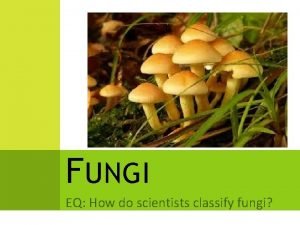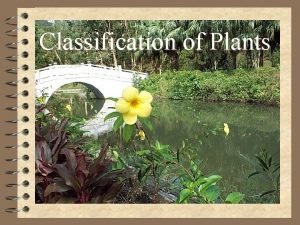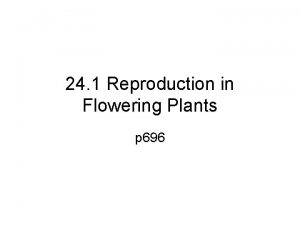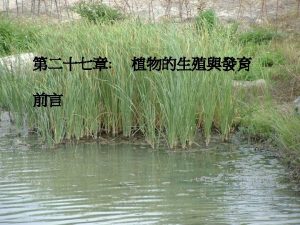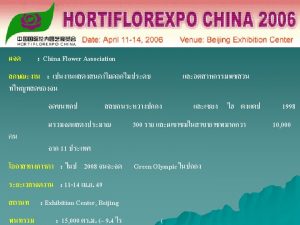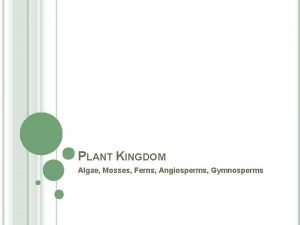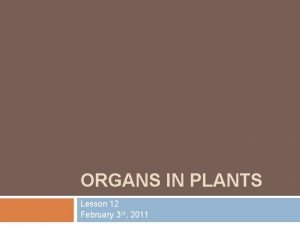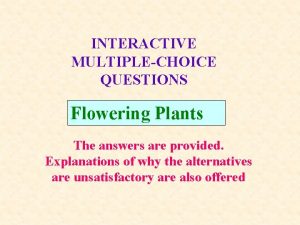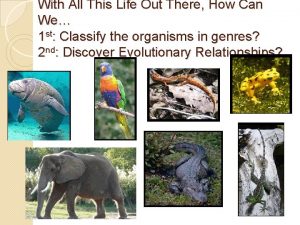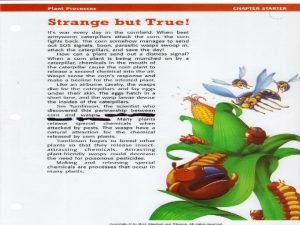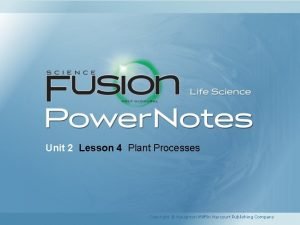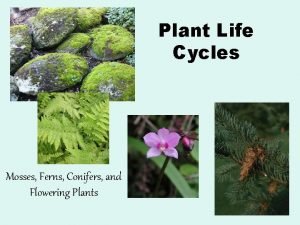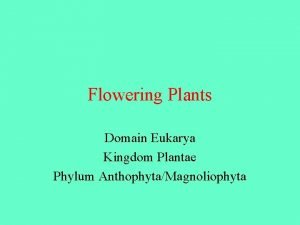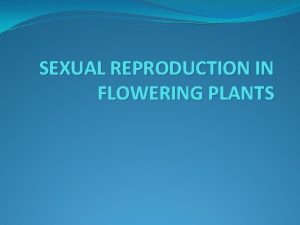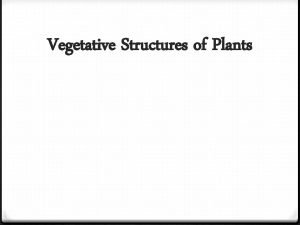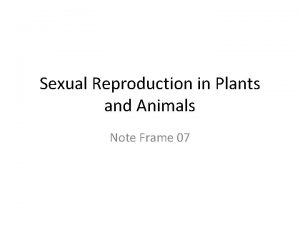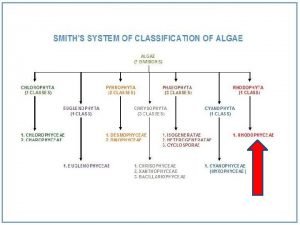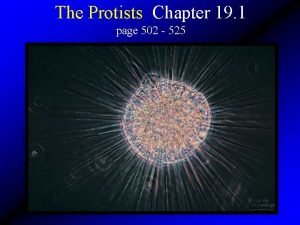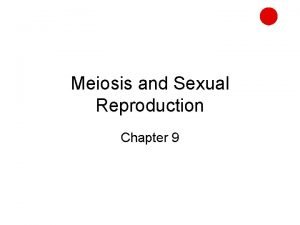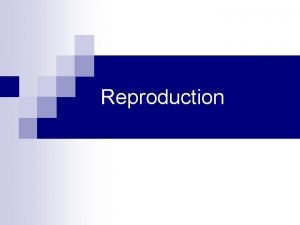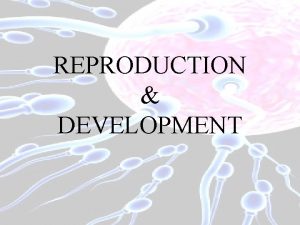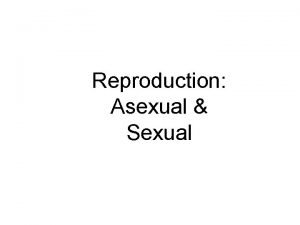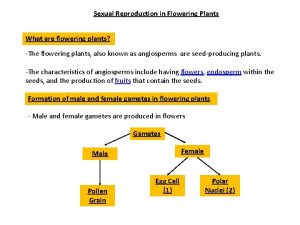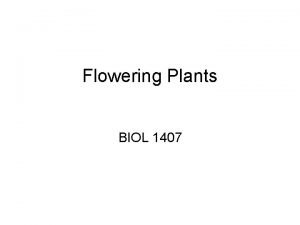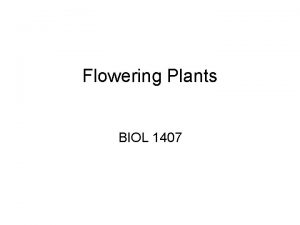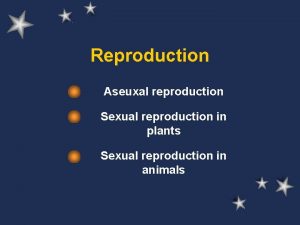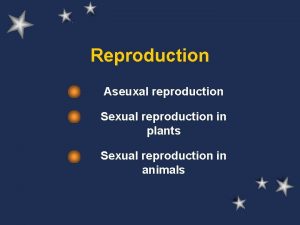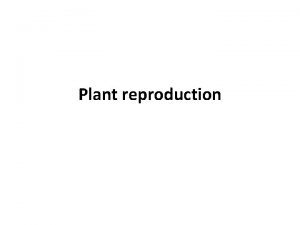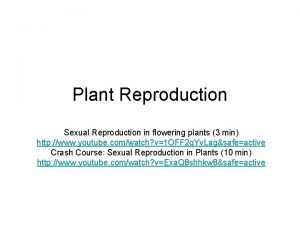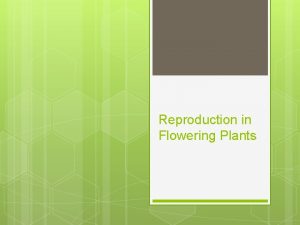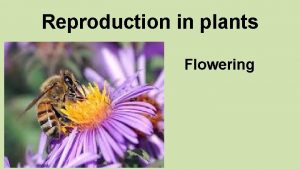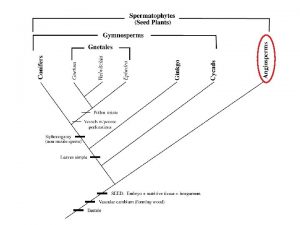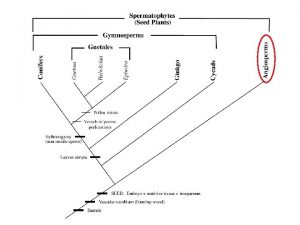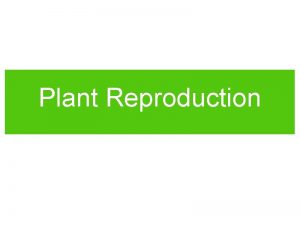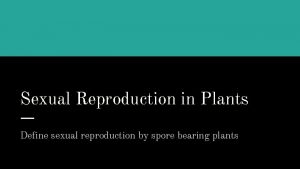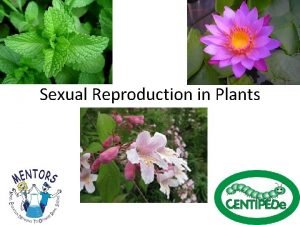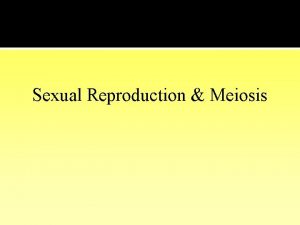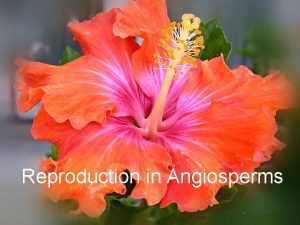Sexual Reproduction in Flowering Plants c Fruit Formation































- Slides: 31

Sexual Reproduction in Flowering Plants c) Fruit Formation & Dispersal

Learning objectives • Outline fruit formation. • Outline seedless fruit production • Outline fruit & seed dispersal and give with examples of wind/water/animal/self dispersal • Explain & emphasise the need for dispersal 2

Seed formation Endospermic & Non-Endospermic Monocots & Dicots

Seed Formation • The zygote grows repeatedly by mitosis to form an embryo • An embryo consists of a plumule (future shoot), a radical (future root) and cotyledons (food stores needed for germination) 3 n Endosperm nucleus 2 n Zygote 4

Seed Formation • The endosperm nucleus (3 N) divides repeatedly to form the endosperm in endospermic seeds. This endosperm acts as a food store for the developing seed 3 n Endosperm nucleus 2 n Zygote • e. g. maize 5

Seed Formation • In non-endospermic seeds the endosperm is used up in the early stages of seed development so the food is stored in the cotyledons • e. g. bean 3 n Endosperm nucleus 2 n Zygote 6

Seed Formation Endosperm Food store for developing embryo Embryo Plumule, radicle, cotyledons Integuments, becomes the seed coat 7

Seed Formation If all the endosperm is absorbed by the developing embryo the seed is a nonendospermic seed e. g. broad bean 8

Seed Formation If all the endosperm is not absorbed by the developing embryo the seed is an endospermic seed e. g. Maize 9

Seed types and structure Plumule (immature shoot) embryo All seeds Seed In some seeds endosperm Radicle (immature root) Cotyledon (food supply or seed leaf) Food store 10

Endospermic Seed e. g. Maize Endosperm Seed coat (testa) Cotyledon Plumule – will develop into a new shoot Radicle – will develop into a new root 11

Non-Endospermic seed e. g. Broad Bean Seed coat (testa) Cotyledon Plumule Radicle 12

Non–endospermic and Endospermic seed Endosperm Cotyledon Plumule Radicle e. g. Broad Bean e. g. Maize 13

Classification of seeds Classified according to two features: 1. Number of cotyledons (Seed leaves) n Monocotyledon – one cotyledon • E. g. Maize n Dicotyledon - Two cotyledons • E. g. Broad bean 2. Presence of endosperm n Present – Endospermic e. g. maize n Absent – Non-endospermic e. g. broad bean 14

Broad Bean – Non-Endospermic Dicot Testa 2 Cotyledons 15

Differences between monocots and dicots Feature Monocot Dicot Number of cotyledons 1 2 Venation Parallel Reticulate (Net) Vascular Bundle arrangement Scattered In a ring Usually in multiples of 3 Usually in multiples of 4 or 5 16 Number of petals

17

18

Fruit formation Seedless fruits Fruit and seed dispersal

Fruit Formation • The ovule becomes the seed • The ovary becomes the fruit 20

Fruit Formation • A fruit is a mature ovary that may contain seeds • The process of fruit formation is stimulated by growth regulators produced by the seeds 21

Seedless Fruits Can be formed in two ways 1. Genetically • Either naturally or by special breeding programmes • e. g. seedless oranges 22

Seedless Fruits 2. Growth regulators e. g. auxins – If large amounts of growth regulators are sprayed on flowers fruits may form without fertilisation – e. g. seedless grapes 23

Fruit and seed dispersal • Need for dispersal – Minimises competition for light, water etc. – Avoids overcrowding – Colonises new areas – Increases chances of survival 24

Types of dispersal 1. 2. 3. 4. Wind Water Animal Self 25

Methods of dispersal 1. Wind n Sycamore and ash produce fruit with wings n Dandelions and thistles produce fruit with parachute devices n Both help to disperse the seeds more widely using wind 26

Methods of dispersal 2. Water • Light, air filled fruits that float away on water • E. g. coconuts, water lilies 27

Methods of dispersal 3. Animal Edible fruit n Animals attracted to bright colours, smells and food n Seed passes through digestive system unharmed n E. g. strawberries, blackberries, nuts 28

Methods of dispersal 3. Animal Sticky fruit n Fruits with hooks that can cling to the hair of an animal and be carried away n E. g. burdock, goose grass 29

Methods of dispersal 4. Self n Some fruits explode open when they dry out and flick the seed away n E. g. peas and beans 30

Go to the next stage in the life cycle Dormancy & Germination Thanks to PDST biology team 31
 Characteristic of non flowering plants
Characteristic of non flowering plants Ascular plants
Ascular plants Classification of ferns
Classification of ferns What part of the flower is female
What part of the flower is female Statolith in plants
Statolith in plants Asexual vs sexual venn diagram
Asexual vs sexual venn diagram Asexual reproduction cell division
Asexual reproduction cell division Sexual reproduction and asexual reproduction
Sexual reproduction and asexual reproduction A sexual reproduction in plants
A sexual reproduction in plants Mosses ferns conifers and flowering plants
Mosses ferns conifers and flowering plants Plant parts name
Plant parts name Lesson 12 flowering plants
Lesson 12 flowering plants Multiple choice questions on flowering plants
Multiple choice questions on flowering plants Phylogenic
Phylogenic Flower male reproductive parts
Flower male reproductive parts Embryo in flower
Embryo in flower Unit 2 lesson 10 seedless plants
Unit 2 lesson 10 seedless plants Conifer life cycle
Conifer life cycle Lilium longiflorum
Lilium longiflorum Parts of a typical flowering plant
Parts of a typical flowering plant Dithecus
Dithecus Parts of roots
Parts of roots Asexual and sexual reproduction difference
Asexual and sexual reproduction difference Red algae is oogamous
Red algae is oogamous Sexual reproduction in paramecia is called _____.
Sexual reproduction in paramecia is called _____. Example of budding asexual reproduction
Example of budding asexual reproduction Section 1 meiosis
Section 1 meiosis Meiosis stages
Meiosis stages Internal fertilization
Internal fertilization Asexual or sexual reproduction
Asexual or sexual reproduction Advantages of genetic diversity
Advantages of genetic diversity Mitosis sexual reproduction
Mitosis sexual reproduction

